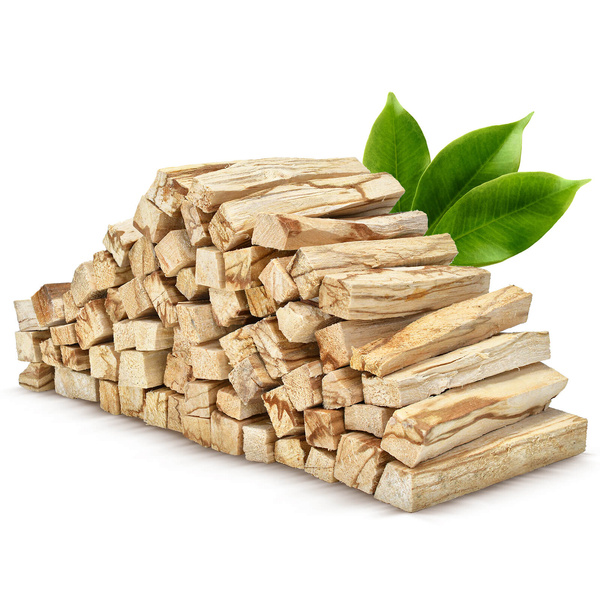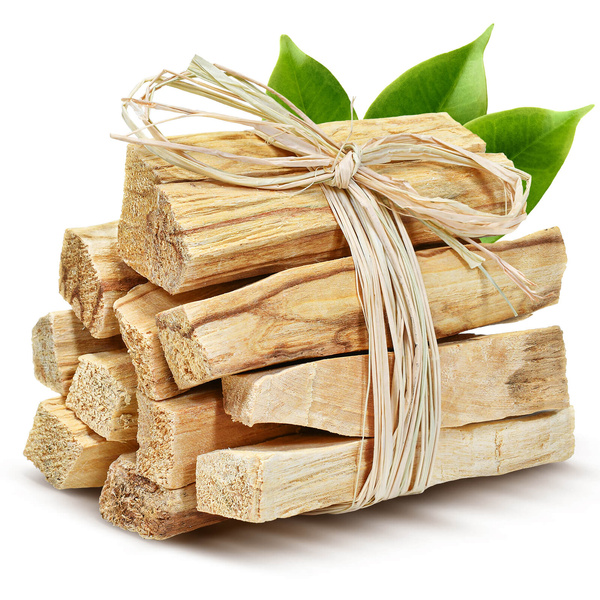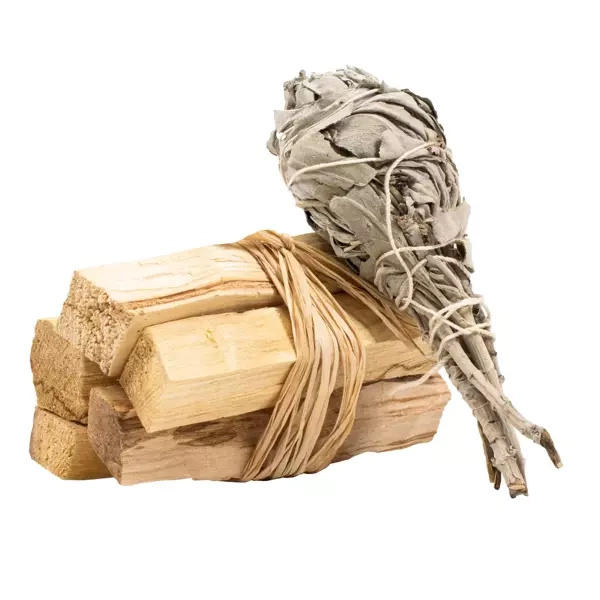The natural magic of incense. How do palo santo and white sage work?

Incenses have been with us for centuries, connecting the human world with the mystical, unattainable reality that lies behind what is familiar to us. The scent and smoke of incense create an atmosphere that helps to concentrate, clear space and raise energy vibrations. Two incenses in particular have gained great popularity in recent times: palo santo and white sage. Like yerba mate, they originate from Indian culture, which is why we have also taken an interest in them. In today's post, we want to share with you their history, uses and the benefits that can be derived from them.
Summary:
- A healthy boost. Caffeine content of yerba mate
- In tribute to nature. Native American incenses
- The cleansing ritual. White sage and palo santo in incense form – how to use?
- Palo santo and white sage – mystical incense of the Indians. Discover their properties
Incense – an ancient, mystical force
For centuries incenses have been appreciated not only for the beautiful aromas they spread around, but also for their valuable properties. Certain herbs, the flowers and leaves of plants, the bark, twigs and resin of trees are rich in aromatic essential oils, which can have a healing effect, influence the physical and mental state, relax, stimulate creativity, affect the emotions and the atmosphere around. Frankincense has been part of religious rituals for thousands of years. They were believed to have mysterious powers – they could protect against evil astral entities or summon good spirits. They accompanied funeral ceremonies, connecting the world of the living with the world of the dead. The aromatic smoke from the incense sticks not only aided meditation, but also allowed one to look into themselves, into the past and into the future. Incense was already used by the ancient Egyptians and Babylonians. In ancient Rome, incense was more valuable than gold. Two thousand years before our era, incense was used by the Chinese in religious ceremonies. Frankincense was also an integral part of the rituals of Buddhist monks in Japan. The sacred magic of nature was also used by the ancient Incas and the Indians who inhabited the Americas hundreds of years ago. They used the smoke of palo santo and white sage, called “sacred tree” and “sacred herb”, to light the sites of rituals. The fragrant smoke rising from the natural incense had great power.
In tribute to nature. Native American incenses
Palo santo – “sacred tree”
Derived from Spanish, the term palo santo actually refers to several species of trees that are found in South and Central America, the most commonly mentioned being Bursera graveolens and Bulnesia sarmientoi (recently reclassified as Gonopterodendron sarmientoi). Guaiacum officinale is also sometimes referred to as a “sacred tree”. In addition to their common name, all these trees have in common the fact that they have very hard, durable wood, rich in extremely aromatic resin, which has been attributed magical properties for centuries. Palo santo wood smells amazing. You can smell sweet and slightly citrusy notes in it. Smoke rises from a glowing piece of wood with an intriguing aroma; the complete opposite of what you would expect from burning wood. The smell of smouldering palo santo incense is heavy, vanilla and spice, yet light, refreshing, mint and citrus. It smells of the Amazonian jungle, freedom and wildness. The aroma that spreads around puts you in a unique, slightly strange, mystical state. It helps you to focus and relax.
Palo santo is not only a fragrant incense. Rich in valuable resin, the wood has many properties. Hard and resistant to external influences, the wood is ideal for the manufacture of a variety of objects. For us mateists, the first things that come to mind are wooden, characteristically scented yerba mate cups. Other utensils and objects for daily use, items of jewellery and even furniture are also made from the "sacred wood". In South America, palo santo is sometimes also referred to as the "tree of life" (lignum vitae), believed to have healing powers. It has been used in folk medicine as a remedy for many ailments. The resin contains a high concentration of limonene and α-terpineol terpenes, which are responsible for the characteristic intense aroma, but also have anti-inflammatory effects, regulate the immune system and relieve stress. The resin of palo santo was used to produce an oil that was applied to combat pain and rheumatism. Sometimes crushed pieces of wood were added to infusions to improve the digestive system.
Unfortunately, due to their properties and wide-ranging uses, and with the ever-growing popularity of palo santo incense going far beyond South American culture, the “sacred trees” have begun to face extinction. Bursera graveolens, Bulnesia sarmientoi and the Guaiacum officinale trees have been placed on the IUCN Red List of Threatened Species, the international organisation for nature protection. Commercial and industrial felling of the trees was banned, and the only way to harvest wood became the collection of dead branches that had spontaneously fallen to the ground. Nowadays, the species Bursera graveolens is not threatened with extinction, but “live” trees are still not felled and instead naturally fallen branches are collected. This is a sign of respect for nature, but also a way to increase the value of the wood. Before the branches are harvested, they lie on the ground untouched for about six years. During this time, numerous chemical reactions take place in them. The wood changes colour and the resin takes on an even more intense aroma.

White sage – sacred incense of the Navajo Indians
White sage (Latin: Salvia apiana) is a plant whose roots can be traced back to ancient North American Indian cultures, especially the indigenous peoples associated with the Navajo, Lakota, Comanche, Arapaho or Cheyenne tribes. It grows in dry, well-sunny areas stretching across the southwestern United States. It has distinctive, spreading leaves, covered with silvery-white mesquite. The leaves are rich in essential oils, whose aroma intensifies when rubbed in the fingers. In incense form, white sage is known for its cleansing and protective properties. Traditionally, Indian shamans burned sage during purification and prayer ceremonies. The precious juices flowing in sage leaves, however, have found use not only as a fragrant substance. Sage infusions were used as a cough remedy. The leaves of the plant were eaten as a cure for fevers and various ailments. The dried, grated seeds were combined with flour and sugar to make a tasty gruel or cakes. The cleansing properties of sage were also used for hygienic purposes – the crushed leaves of the plant were mixed with water and used as a hair shampoo.
White sage in incense form gives off a very intense, pleasant, herbal aroma. The smoke smells of light sweetness, vanilla and spices. It has the power to cleanse – spaces, places, objects, people, energies. It relieves tension by making the body and mind enter a state of relaxation. The smoke smouldering from the white sage releases bad energy and negative feelings, cleanses the soul and facilitates the acceptance of the positive. As with palo santo, Indian shamans believed that white sage used as incense had the power to protect against evil entities and attract good spirits.
The cleansing ritual. White sage and palo santo in incense form – how to use?
The ritual of cleansing, or smudging, has been present in many cultures for thousands of years. It has religious and spiritual significance and accompanies meditation and prayer. Although incense of various kinds is nowadays quite widely available and virtually anyone can perform the ritual in their own home, it is worth remembering that it is a symbol of certain communities and has a much deeper meaning for them. White sage and palo santo come from nature, and the ancient Indians believed that plants, like animals and humans, possessed a soul. They believed that through burning incense they contact with the spirit of nature, merged with the nature around them and thus achieved complete harmony. The ritual of burning should therefore be approached with due respect.
White sage and palo santo in the form of incense have been shown to have a purifying effect. They help you to focus and relax, so it is worth incorporating them as part of mindfulness practices such as relaxation exercises, meditation or yoga. The fragrant smoke of incense cleanses space, objects and people of bad energy, so it is worth using the ritual, for example, when closing a difficult stage in life, after an argument with a loved one or when moving to a new place. How to use natural incense? It is a good idea to start the cleansing ritual with tidying up to avoid energetic chaos. Light a bunch of sage or a piece of palo santo wood by holding it over the flame of the fire. Wait until the incense begins to glow. Blow out the flame or shake the incense vigorously and it begins to smoulder with a thick, fragrant smoke. As the flame is extinguished, it is helpful to think of an intention to accompany the incense ritual. The cleansing begins with oneself, directing the incense from head to toe, and then slowly incense the dwelling, objects or persons with the smoke. The still glowing incense should be put away in a safe, heatproof place, such as a ceramic vessel.
Palo santo and white sage – mystical incense of the Indians. Discover their properties
If you are interested in natural, “sacred” incenses made from palo santo and white sage and want to bring some ancient Indian magic into your life, we invite you to visit our shop. We have recently added original, natural incenses – palo santo straight from Ecuador and white sage from Arizona, Utah and New Mexico. Remember to use them with respect and sensitivity, honouring the tradition and culture from which they originate. Be aware of and appreciate the power of mystical incense to support spiritual practices and personal growth journeys.
Source of information:
- Wikipedia: Incense, Bulnesia sarmientoi, Bursera graveolens, Guaiacum officinale, Salvia apiana.
- The IUCN Red List Of Threatened Species.
- L. Monzote and others, Chemical Composition and Anti-proliferative Properties of Bursera graveolens Essential Oil, Natural Product Communications, 2012.




